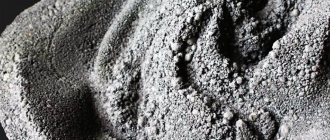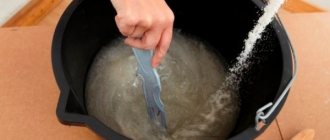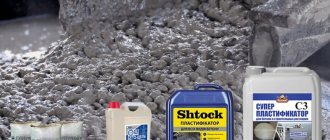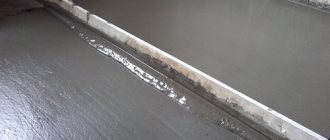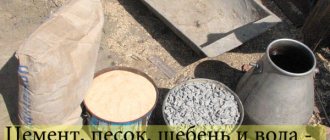When performing construction work, a concrete solution is used. This material is created on the basis of a binder component, sand and additives that promote strength and other performance properties. Due to the affordable price, reliability and ease of creating concrete, anyone can prepare it.
Characteristics of concrete
The characteristics of a building material are determined by such indicators as the proportions of concrete and its composition. They affect the quality of the final product and its class.
Class means a numerical coefficient of important parameters with a probability of 0.95. In the international classification, the letter B is indicated before the digital value that determines the permissible pressure on the material. The grade of concrete indicates maximum resistance to contraction and is designated by the letter M. Almost 45% of the final characteristics of the solution depend on it.
It is important to consider other factors, including:
- Quality of raw materials.
- Proportions.
- Cooking method.
So, if you produce material with the M400 grade in a manual concrete mixer, the output will be a B25 class product. When using industrial devices, the result is B35.
To convert a concrete grade into a class, you must be guided by the following classification:
- M100 - belongs to class B7.5 and is intended for preparatory work when arranging the foundation.
- M150 - corresponds to B12.5. The material is in demand when installing screeds, floor coverings or small bases.
- M200 - class B15. It is in particular demand and is used in the organization of floors, foundations, concrete stairs, road and parking areas, etc.
- M250 (B20) - used for the construction of foundations, fences and stairs.
- M350 - belongs to class B25 and is a key solution for creating slabs, beams, pools and foundations.
- M400 - corresponds to class B30 and is developed for construction work in difficult conditions. In most cases, such material is used in the construction of bridges, financial institutions or other objects with high power requirements.
Waterproof
Before making concrete with your own hands, you need to study such a parameter as water resistance. It indicates the ability of concrete to withstand moisture and not deform.
Depending on the degree of moisture resistance, cellular products are divided into the following brands:
- W2.
- W4.
- W6.
- W8.
- W12.
There are concretes with a high degree of water resistance, which are used in difficult conditions and have the following advantages:
- They can be used when constructing buildings in an environment with close groundwater.
- They are resistant to temperature changes.
The level of moisture resistance is determined by the method of preparing the concrete mixture, the composition and the presence of special fillers. This indicator also depends on the internal structure of the concrete.
Frost resistance
The composition of concrete affects the degree of frost resistance of the finished product. This indicator refers to the number of defrosting and freezing cycles without visible defects, destruction and loss of strength. If the material is of high quality, its service life will exceed several decades. In the absence of quality control, products with little resistance to frost are put on sale.
The frost resistance value is indicated by the letter F, and then a numerical indicator is indicated - 50-1000, which reports the cycles.
Strength
Before mixing concrete, it is important to pay attention to such a characteristic as strength. It is measured in megapascals (MPa) and indicates the maximum pressure that a concrete product can withstand. Compressive strength is not a fixed parameter and can change as the binder additives are exposed to liquid.
Strength properties are displayed in a grade or class, but the exact value can only be determined a couple of weeks after pouring (in most cases, strength development takes about 28 days).
Such a term depends on several factors, including the temperature regime at which hardening occurs.
At subzero temperatures, the material freezes and cannot gain strength. To speed up the process it is heated. If concrete was laid in winter, but with the arrival of spring it began to thaw, the set of strength properties will be restored, but the characteristics of the product will deteriorate.
Under normal conditions, at positive temperatures, strength is gained more intensively. In just 7 days, the strength indicators will be 70%. However, the structure cannot be used for its intended purpose at this value, so it is not worth dismantling the formwork yet. Full strength gain is completed after 28 days.
As the temperature rises, the hardening process accelerates. In this case, it is necessary to take into account the moisture level of the material: if it dries quickly, the strength gain is suspended. Therefore, at enterprises the solution is treated with hot steam. When mixing concrete by hand, other methods of maintaining moisture are used, including covering the mixture with plastic or wet burlap.
When wondering how to prepare concrete for a foundation with your own hands, it is important to pay special attention to its strength properties. Leading manufacturers indicate strength in design documentation, which simplifies the process of choosing the appropriate option. But if you have doubts about the indicated values, you can independently determine the strength:
- Destructive method. Concrete products are placed on a flat surface, after which a special press begins to act on them. As a result, the compressive strength of concrete samples is determined.
- Non-destructive method. Provides mechanical impact on concrete using ultrasonic equipment, shock pulse or elastic rebound. A series of mathematical calculations are also performed to determine the strength properties.
Plastic
The plasticity of concrete refers to the specificity of its distribution over voids and surfaces. To determine mobility, a truncated cone is used, inside which the mixture is placed in 3 stages, acting on it with a reinforcing bar.
Then the cone is turned over with its wide base down and lifted back up. The solution will begin to spread over the surface, and the difference in height between the cones will indicate the settlement of the cone (OK).
A more complex but accurate technology involves analyzing the monolith. To carry out the procedure, you need to place the finished mixture in cubic molds and wait for it to harden. After 28 days, you need to evaluate the product.
Marking of concrete and cement
The grade of cement characterizes its compressive strength (kilogram per square centimeter of a concrete cube with a side of 20 cm 28 days after its manufacture). If there are additional impurities in the cement, then additional letters are indicated in the marking (for example, M (PTs) 400 - D20).
The most commonly used grades of cement in the preparation of concrete are M350 and M500 .
The grade of concrete (M50 - M1000) also reflects its average characteristics. In this case, the marking of concrete depends on the amount of cement used in the preparation of the mixture. The marking of concrete also indicates its class - B1 - B60, which is an indicator of strength.
Do-it-yourself concrete - main components
When choosing the composition of concrete for the foundation, proportions and ratios, it is necessary to prepare the following components:
- Cement mixture.
- Sand.
- Crushed stone.
- Water.
Cement
For novice developers who understand how to prepare concrete at home, it is important to correctly calculate the amount of binder - cement.
There are different types of cement mixtures available in the market including Portland cement, slag Portland cement, rapid setting compounds and others. Each option has its own properties, speed of strength gain and scope of application.
Traditional concrete composition and proportions include Portland cement due to its improved performance and availability. Available materials are divided into grades with the letter M and a numerical value that determines resistance to loads.
To make concrete with your own hands, it is customary to use the M400 brand - it has sufficient strength and reliability. Industrial production in Moscow uses Portland cement M500, and for the construction of foundations in difficult conditions, special compounds of a higher grade are used.
To prepare a concrete mixture, you need to know exact information about the brand and quality of the component used. It is also important to take into account such a property as freshness - the shelf life of a concrete product depends on it.
The fresh mixture is a crumbly dust with no compactions or lumps. If there are large elements in cement, it is better not to use it for construction work.
Sand
The concrete recipe for the foundation requires the presence of sand. There are different types of such a component, which differ in their composition and properties, and also determine the quality of the final product.
When figuring out how to make a concrete solution, you can choose any type of sand. The main thing is that they do not contain large amounts of dust, clay and large particles that worsen the properties of the mixture.
Experts recommend choosing sea or river sand, since these types do not contain dust, clay and organic compounds. As for raw materials mined in quarries, they can be quite dirty and require preliminary preparation with washing and settling.
This sand may also contain organic debris, including tree roots, leaves, bark and branches. If such particles end up in the concrete mixer, the concrete will be of poor quality and its strength will deteriorate.
An indicator such as sand moisture should be assessed. Even in dry material, up to 2% water can be present, and in wet material - up to 10%. In this case, the ratio of concrete for the foundation will be violated.
Crushed stone, gravel
When studying what a concrete mixture consists of, you need to pay attention to crushed stone and gravel. These rocks act as fillers and are responsible for the strength of concrete products. In most cases, crushed stone is used, which has different fractions and surfaces.
When preparing the composition, you cannot replace the filler with sea or river pebbles, since these components have a smooth polished surface and do not provide good adhesion to other components.
The proportions of the concrete solution affect the service life and reliability of the product. The permissible size of stones in crushed stones should not be more than 1/3 of the minimum thickness of the structure being built. The hollowness of the crushed stones or the amount of space between the stones is also taken into account.
To calculate this parameter, you need to take a bucket, place the filler there and gradually add liquid. The volume of water placed will indicate the void ratio. Therefore, experts calculate the proportions of concrete for the foundation in buckets.
To improve the process of filling voids with concrete mixture, it is recommended to combine different fractions of crushed stone. In addition to gravel and granite crushed stone, the following fillers can be added to the composition:
- Expanded clay.
- Blast furnace slag.
When creating lightweight concrete, wood shavings or expanded polystyrene granules are used.
Water
When starting to mix concrete, you need to take care of water. It is recommended to take drinking liquid that is used for household needs. It is prohibited to use water from questionable sources, waste water or swamp water. Depending on the ratio of components in concrete, its operational properties are determined.
When performing calculations, it is necessary to take into account the content of all moisture that is in the feedstock before mixing. If the composition includes blast furnace slag, it is important to determine what moisture content such material has, since “excess” water can worsen the characteristics of concrete.
The volume of liquid affects the mobility of the material. To create plastic concrete, it is necessary to adhere to proportions and not deviate from the given norm. Otherwise, the mixture will begin to separate and deform.
The degree of plasticity can be determined visually after the concrete has hardened. If it randomly slides off the bayonet shovel, this indicates good ductility. When sliding slowly, the mixture is said to be of little plasticity, and the solution held on the shovel by a tubercle is classified as non-plastic.
Supplements
To mix the solution and improve its quality properties, good proportions for concrete components include the presence of additives. They are intended to increase frost resistance and resistance to corrosion processes, reduce hardening time, change strength properties and other purposes.
Existing components are selected according to the following classification:
- Plasticizers - used to increase the strength and density of concrete.
- Air-entraining additives are used to obtain a porous structure, which increases the resistance to negative temperatures of reinforced concrete structures.
- Impurities to accelerate hardening - allow you to reduce the hardening time of the mixture. There are impurities with the opposite principle of action that slow down the setting process.
- Compaction additives - help increase durability and fill cavities between concrete grains.
- Corrosion inhibitors - can create an oxide film on the anode.
- Gas-forming elements - used in the production of gas blocks. Capable of increasing water resistance and reducing the intensity of delamination.
- Anti-frost - intended for construction work at temperatures down to -20°C.
When selecting suitable admixtures, it is necessary to consider the type of task they perform. Modern components are capable of:
- Improve the performance characteristics of concrete.
- Increase strength and resistance to moisture, corrosion or frost.
- Reduce the hardening period.
- Reduce component consumption.
- Influence mobility indicators.
Concrete, classification
| Classification | Weight, kg/m3 | Scope of use |
| Extra heavy | More than 2500 | nuclear power plant |
| Heavy | From 1800 to 2500 | Manufacturing of foundations, reinforced concrete structures, other construction work |
| Easy | From 500 to 1800 | Manufacturing of floors, panels, wall blocks |
| Particularly light | Less than 500 | Thermal insulation of building facades |
In addition, specialized concretes have been developed, characterized by the presence of special impurities in them that improve certain characteristics (thermal conductivity, strength, density, etc.). For example:
- heat-resistant (resistant to heat up to 1000 degrees);
- road (especially bending and frost-resistant);
- hydraulic (highly resistant to corrosion, waterproof, increased density);
- airfield and other types of concrete for special purposes.
Calculation of concrete composition by weight
When figuring out how to make strong concrete, you need to correctly calculate the composition, guided by the following information:
- Required brand of mixture.
- Required ductility.
- Brand of cement.
- Information about sand and crushed stone.
Developers use two methods of calculations, taking into account the following ratios:
- Volumetric.
- Weight.
To calculate the composition of a concrete mixture by weight, you need to use some formulas. When using Portland cement M400 and crushed stone with a medium fraction, first of all you need to find the ratio of water and cement (W/C). W/C - indicates the proportion of the weight of the liquid and the cement mixture that will be needed to obtain strength properties. Formulas or experiments are used to determine exact values.
If you have information about the brand of concrete and the brand of cement, you need to find the W/C. As an example, we can take the number 0.68.
Using the table, you need to determine the volume of liquid to create a mixture of medium plasticity when using crushed stone measuring 40 mm. The result will be 190 l/m³. Next you need to find the optimal amount of cement mixture per 1 m³ of concrete. To do this, 190 l/m³ is divided by 0.68, which will give an indicator of 279 kg of cement.
Concrete recipe - everything has already been invented for us
Calculator for calculating the selection of concrete composition
Not a single legally binding regulatory document regulates the specific proportions of sand and cement for concrete. There are too many factors influencing this. But some provisions on the recipe can be found in GOST 27006-86 “Concrete. Rules for selecting the squad."
Again, it reflects everything in general terms. But I just want to know how much cement, sand, crushed stone is in 1 m3 of concrete of a particular brand. Such an opportunity exists today - composition selection calculators.
You simply enter the required class and brand of cement and get the desired recipe. But you should not treat it as a truly correct option. These figures are approximate.
The tables above show the approximate rates of cement, sand, and crushed stone for the most popular brands of concrete. Such values need to be adjusted after laboratory tests of test batch samples.Methods for mixing concrete
If you are interested in how to properly prepare concrete, you should study the following methods:
- Manual.
- Mechanized.
You can mix concrete in special equipment - mixers or concrete mixers.
Manual
In private construction, it is customary to connect components manually, using the correct proportions of the concrete mixture. For kneading, prepare a container in which all components are mixed. You can use a tin trough or other suitable structure.
First you need to place sand in it, and pour cement mixture into the furrow in the central part. After thoroughly mixing the components, liquid is added to the solution and it is mixed again. Then crushed stone is added, mixing continues with periodic addition of water. Once a homogeneous consistency has appeared and the stones have been filled with solution, you can proceed to laying.
The key disadvantage of the manual method is its low speed. Any delays can lead to delamination of the material in the trough, as a result of which its properties will deteriorate. Therefore, experts recommend quickly placing the composition into the formwork, avoiding long pauses.
The best option for creating a mixture is to knead it in a concrete mixer. It allows you to obtain a homogeneous consistency of high quality.
Mixing in a concrete mixer
When preparing concrete with your own hands, proportions can be measured in buckets, and mixing can be done in a concrete mixer. The device produces a homogeneous emulsion with improved performance properties. Liquid and fillers are added to the creamy consistency.
The mechanical method prevents the problem of concrete delamination, and the material can remain in a rotating unit for up to 1 hour without losing its working qualities. But in order to preserve the positive properties of the material, it is better to place the concrete mixer at the construction site to avoid problems when delivering the solution to the site.
Components
Any concrete, regardless of its brand, consists of the following components:
- Cement.
- Sand.
- Crushed stones or gravel.
- Water.
All these components must have the necessary characteristics, taking into account which they must be selected. Cement is the main ingredient in a concrete mixture because it is a binder. It is produced by cement factories. Cement is divided by grade and by the number of various additives it contains. The most popular Portland cement, it contains many special additives to improve the properties of the material. When pouring the foundation of a house, experts recommend that private developers use cement M 400 or PC 400.
You need to keep in mind, like many building mixtures, the shelf life of cement is limited. After a year of storage in packaging, it significantly loses its activity, which determines the properties and brand of the material.
Sand is one of the aggregates in concrete mixtures. To obtain a high-quality solution, you need to take its choice seriously. It is worth noting that at the moment the choice of sand on the construction market is huge. If you wish, you can even purchase sand from the seabed, but not every sand material is suitable for concrete.
Thus, experts do not recommend using sand with clay admixtures for this purpose. Because of this, concrete is less durable and frost-resistant. But with river sand you can prepare a solution that is ideal in condition. It is often of very high quality and consists of homogeneous fractions.
Crushed stone and gravel , as well as sand in the solution, act as fillers. Thanks to them, the solution “shrinks” less, which makes the concrete structure stronger and more durable. When choosing crushed stone, you should pay attention to its shape. Because the convenience of pouring concrete mortar depends on it.
Flat and angular crushed stone is usually not used for mixing concrete. Because it requires more consumption of other components, which affects the strength of the structure. The best option for pouring the foundation is the use of crushed gravel. It consists of particles ranging in size from 3 to 70 mm. In addition, it is affordable for private developers.
Water. This component can have any characteristics, the main thing is that the water is clean without any impurities. Having all the above components and knowing the proportions of concrete for the foundation, you can prepare a solution of any required brand.
Table: concrete made from cement M500
When creating concrete manually, the proportions with the M500 cement grade are calculated using the following table:
| Cement brand | M500 | |||||||
| Concrete grade | M150 | M250 | M350 | M450 | ||||
| Cement | kg | 1 | ||||||
| Water | ||||||||
| 0,5 | ||||||||
| Sand | ||||||||
| Crushed stone | 4,5 | 2,6 | 1,9 | 1,1 | ||||
| 6,6 | 4,5 | 3,6 | 2,5 | |||||
| Proportions (C/P/SH) | 1/ 4,5/6,6 | 1/ 2,6/4,5 | 1/1,9/3,6 | 1/1,1/2,5 | ||||
Example of calculating material requirements
Initial data: you need to get 10 cubic meters. M200 concrete using M400 cement.
The data is taken from the table: the ratio by volume (not by mass!) of cement / sand / crushed stone is 1 / 2.5 / 4.2 (second column of the table for concrete grade M200). Total 7.7 parts, respectively, 1 part = 10 cubic meters / 7.7 = 1.3 cubic meters.
By means of a simple calculation, the need for each material is obtained:
- Cement – 10/7.7*1 = 1.30 cubic meters. meter.
- Sand – 10/7.7*2.5 = 3.25 cubic meters. meter.
- Crushed stone - 10/7.7*4.2 = 5.46 cubic meters. meter.
Please note that these calculations are given specifically for the volume of each building material, and not for mass.
Required grade of concrete for pouring a foundation in different soils (see Grade of concrete for strip foundation):
- M-200 (B 15) for dry and wet soils. (see How much cement is needed per 1 m3 of M200 concrete).
- M-300 (B 22.5) for moisture-saturated soils (see How much cement is needed per 1 m3 of M300 concrete).
Factors influencing the ratio of concrete components:
- Brand of concrete. Any design documentation must contain information about the required grade of concrete. In private housing construction, as a rule, M200 and M250 concrete is most often used, and in the most critical structures M300 and M350.
- Brand of cement. Typically, the most economical and at the same time high-quality concrete is considered to be concrete made from cement, the grade of which is one and a half to two times higher than the required grade of the final product. Therefore, the most common cement is M400 and M500. It is for these brands that the table is calculated.
All numbers are relative, since the grade of concrete depends on many components: the grade of cement, the quality of sand and crushed stone, the softness of the water, and the addition of various types of plasticizers. In the industrial production of concrete, more than 10 indicators and characteristics of materials are taken into account. As an example: M400 cement produces M250 concrete, and M500 cement produces M350 concrete. Although these figures are conditional, since the strength and quality of concrete depend on all components as a whole.
In all regulatory documents, as well as in information for general use, concrete is indexed with letters and numbers, and the following must be indicated:
- M – grade, an indicator of resistance to critical compression of concrete, measured in kgf/cm2.
- P – mobility.
- B – class, measured in megapascals MPa, the pressure that concrete can withstand.
- F – frost resistance.
- W – waterproof.
It is also necessary to know that all components required for the preparation of concrete are measured in parts of the volume.
Also, when mixing concrete, it is necessary to take into account that the thinner the consistency, the greater the shrinkage of concrete: rigid concrete 0 - 20 mm, plastic 60 - 140 mm, cast concrete 170 - 220 mm.
Calculation of cement per 1 cubic meter of concrete (m³)
The proportional ratio of cement to other binding materials affects the mobility of the concrete mixture. In order to prepare high-quality building materials, the following ratios should be adhered to:
- cement up to 1 kg;
- sand up to 3 kg;
- crushed stone up to 5 kg.
Failure to comply with all component ratios leads to a decrease in the strength characteristics of the future building coating. This will lead to rapid wear and cracking of the surface. The quantitative consumption of cement per 1 m³ of solution directly depends on the brand of concrete mixture planned by the manufacturer. Under different climatic conditions and construction zones, different grades of material are used.
Concrete marking classifier
Table of the ratio of classes and grades of concrete.
For various requirements for the stability and reliability of a construction project, the following marking classifier of concrete mixtures is mainly used:
- M100. It is used at the initial (preparatory) stage of construction work.
- M200. Has a wider range of applications. Most often used when filling foundation surfaces.
- M300. This building material has great strength characteristics. The foundation laying with such a concrete monolith is used in industrial construction.
- M400. It is used in the construction of hydraulic structures. It has high strength and differs from other types of concrete by its rapid hardening.
Decoding of the building material: the letter M with a number that indicates the arithmetic mean value of the strength characteristics of the sample, for compression in kgf/cm².
How many cubes of concrete are needed for the foundation?
When constructing a civil or industrial facility, two types of foundation coverings are used: strip and slab foundations. For the convenience of calculation indicators, a reinforced concrete (reinforced concrete) foundation of 10 by 10 is taken:
- Strip foundation. The required amount of construction mixture is determined by the total volume of the base. The calculation is carried out by multiplying metric values: height, length and width of reinforced concrete tape. Initial data: height - 1.5 m, width - 0.5 m, total length of the tape - 55 m. Multiplying the values and rounding the value to a whole number, we get 41 cubic meters of concrete.
- Slab base. The amount of concrete mixture is determined very simply for a slab foundation. For example, the thickness of the slab is 40 cm. Multiplying the initial data, we get: 10 m x 10 m x 0.4 m = 40 m³.
Weight of 1 m³ of concrete mixture
The specific gravity of the binding building material is a variable value.
The mass of concrete weighs differently, depending on its structural components, that is, on the type of aggregate. In civil and industrial construction, a heavy type of concrete monolith is usually used. Gravel and crushed stone of large fractions are used as filler. Thanks to this base, the foundation coating has a particularly durable and stable surface. The weight of one cubic meter of concrete mixture ranges from 1.7 to 2.5 tons.



